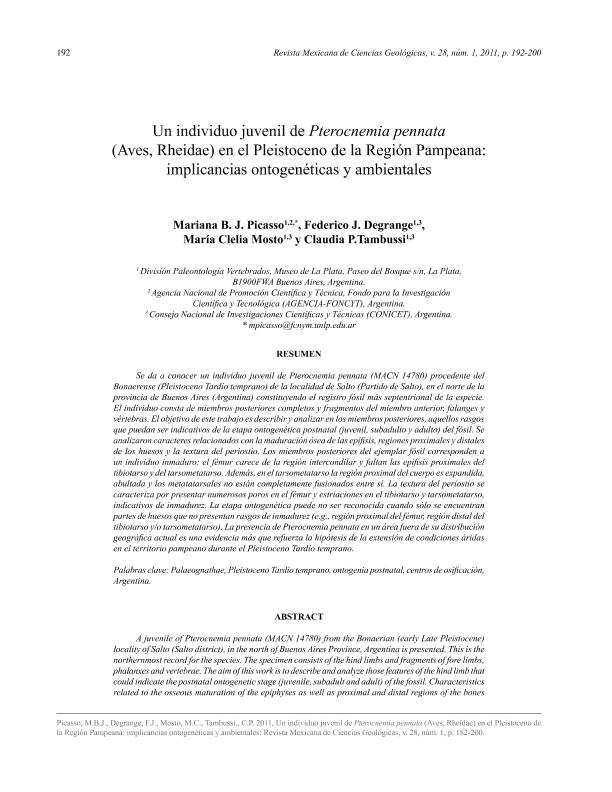Mostrar el registro sencillo del ítem
dc.contributor.author
Picasso, Mariana Beatriz Julieta

dc.contributor.author
Degrange, Federico Javier

dc.contributor.author
Mosto, María Clelia

dc.contributor.author
Tambussi, Claudia Patricia

dc.date.available
2018-07-30T18:41:39Z
dc.date.issued
2011-03
dc.identifier.citation
Picasso, Mariana Beatriz Julieta; Degrange, Federico Javier; Mosto, María Clelia; Tambussi, Claudia Patricia; Un individuo juvenil de Pterocnemia pennata (Aves, Rheidae) en el Pleistoceno de la Región Pampeana: implicancias ontogenéticas y ambientales; Universidad Nacional Autónoma de México. Centro de Geociencias; Revista Mexicana de Ciencias Geológicas; 28; 1; 3-2011; 192-200
dc.identifier.issn
1026-8774
dc.identifier.uri
http://hdl.handle.net/11336/53449
dc.description.abstract
Se da a conocer un individuo juvenil de Pterocnemia pennata (MACN 14780) procedente del Bonaerense (Pleistoceno Tardío temprano) de la localidad de Salto (Partido de Salto), en el norte de la provincia de Buenos Aires (Argentina) constituyendo el registro fósil más septentrional de la especie. El individuo consta de miembros posteriores completos y fragmentos del miembro anterior, falanges y vértebras. El objetivo de este trabajo es describir y analizar en los miembros posteriores, aquellos rasgos que puedan ser indicativos de la etapa ontogenética postnatal (juvenil, subadulto y adulto) del fósil. Se analizaron caracteres relacionados con la maduración ósea de las epífisis, regiones proximales y distales de los huesos y la textura del periostio. Los miembros posteriores del ejemplar fósil corresponden a un individuo inmaduro: el fémur carece de la región intercondilar y faltan las epífisis proximales del tibiotarso y del tarsometatarso. Además, en el tarsometatarso la región proximal del cuerpo es expandida, abultada y los metatatarsales no están completamente fusionados entre sí. La textura del periostio se caracteriza por presentar numerosos poros en el fémur y estriaciones en el tibiotarso y tarsometatarso, indicativos de inmadurez. La etapa ontogenética puede no ser reconocida cuando sólo se encuentran partes de huesos que no presentan rasgos de inmadurez (e.g., región proximal del fémur, región distal del tibiotarso y/o tarsometatarso). La presencia de Pterocnemia pennata en un área fuera de su distribución geográfica actual es una evidencia más que refuerza la hipótesis de la extensión de condiciones áridas en el territorio pampeano durante el Pleistoceno Tardío temprano.
dc.description.abstract
A juvenile of Pterocnemia pennata (MACN 14780) from the Bonaerian (early Late Pleistocene) locality of Salto (Salto district), in the north of Buenos Aires Province, Argentina is presented. This is the northernmost record for the species. The specimen consists of the hind limbs and fragments of fore limbs, phalanxes and vertebrae. The aim of this work is to describe and analyze those features of the hind limb that could indicate the postnatal ontogenetic stage (juvenile, subadult and adult) of the fossil. Characteristics related to the osseous maturation of the epiphyses as well as proximal and distal regions of the bones and to the periosteum texture were analyzed. The specimen hind limbs showed features which could be attributed to an immature age: the femur lacks the intercondylar region and the proximal epiphyses of the tibiotarsus and tarsometatarsus are absent. In addition, the proximal region of the tarsometatarsus is expanded and bulky and the metatarsals are not completely fussed among each other. The texture of the periosteum is characterized by numerous porous in the femur and striations in the tibiotarsus and tarsometatarsus, which are indicative of immatureness. The assignment to the postnatal ontogenetic stage could be misinterpreted if the fragmentary remain belongs to those parts that do not show immaturity features in a juvenile (e.g. proximal region of femur, distal region of tibiotarsus and/or tarsometatarsus). The presence of a new specimen of Pterocnemia pennata in a territory outside its current geographical distribution is another evidence that reinforces the hypothesis of arid conditions for this region during the early Late Pleistocene.
dc.format
application/pdf
dc.language.iso
spa
dc.publisher
Universidad Nacional Autónoma de México. Centro de Geociencias

dc.rights
info:eu-repo/semantics/openAccess
dc.rights.uri
https://creativecommons.org/licenses/by-nc-nd/2.5/ar/
dc.subject
Palaeognathae
dc.subject
Pleistoceno Tardío temprano
dc.subject
Ontogenia Postnatal
dc.subject
Centros de Osificación
dc.subject
Argentina
dc.subject.classification
Meteorología y Ciencias Atmosféricas

dc.subject.classification
Ciencias de la Tierra y relacionadas con el Medio Ambiente

dc.subject.classification
CIENCIAS NATURALES Y EXACTAS

dc.title
Un individuo juvenil de Pterocnemia pennata (Aves, Rheidae) en el Pleistoceno de la Región Pampeana: implicancias ontogenéticas y ambientales
dc.type
info:eu-repo/semantics/article
dc.type
info:ar-repo/semantics/artículo
dc.type
info:eu-repo/semantics/publishedVersion
dc.date.updated
2018-07-23T17:28:13Z
dc.identifier.eissn
2007-2902
dc.journal.volume
28
dc.journal.number
1
dc.journal.pagination
192-200
dc.journal.pais
México

dc.journal.ciudad
Ciudad de México
dc.description.fil
Fil: Picasso, Mariana Beatriz Julieta. Museo de la Plata División Paeontología Vertebrados; Argentina
dc.description.fil
Fil: Degrange, Federico Javier. Universidad Nacional de La Plata. Facultad de Ciencias Naturales y Museo; Argentina
dc.description.fil
Fil: Mosto, María Clelia. Universidad Nacional de La Plata. Facultad de Ciencias Naturales y Museo; Argentina
dc.description.fil
Fil: Tambussi, Claudia Patricia. Consejo Nacional de Investigaciones Científicas y Técnicas. Centro Científico Tecnológico Conicet - Córdoba. Centro de Investigaciones en Ciencias de la Tierra. Universidad Nacional de Córdoba. Facultad de Ciencias Exactas Físicas y Naturales. Centro de Investigaciones en Ciencias de la Tierra; Argentina
dc.journal.title
Revista Mexicana de Ciencias Geológicas

dc.relation.alternativeid
info:eu-repo/semantics/altIdentifier/url/http://www.rmcg.unam.mx/index.php/rmcg/article/view/620
Archivos asociados
